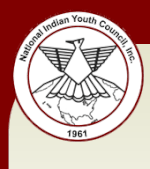
Back Nasjonale Yndiaanske Jeugdried Frisian 全米インディアン若者会議 Japanese Национальный совет индейской молодёжи Russian
 | |
| Founded | August 10–13, 1961 Gallup, New Mexico |
|---|---|
| Founders | Mel Thom (Walker River Paiute) Herb Blatchford (Diné) Shirley Hill Witt (Mohawk) Clyde Warrior (Ponca) Joan Noble (Ute) Bernadine Eschief (Shoshone-Bannock-Pima) Howard McKinley Jr. (Navajo) Edison Real Bird (Crow) Karen Rickard (Tuscarora) John R. Winchester (Pottawatomie) Viola Hatch (Arapaho) |
| Type | 501 (c)(3) non-profit organization |
| Location |
|
| Website | www |
With the belief that we can serve a realistic need, the National Indian Youth Council dedicated its activities and projects to attaining a greater future for our Indian People.
— Mel Thom (Walker River Paiute), the NIYC's first president[1]: 59
The National Indian Youth Council (NIYC) is the second oldest American Indian organization in the United States with a membership of more than 15,000.[2] It was the second independent native student organization, and one of the first native organizations to use direct action protests as a means to pursue its goals. During the 1960s, NIYC acted primarily as a civil rights organization. It was very active in the movement to preserve tribal fishing rights in the Northwest.[2]
In the 1970s NIYC focused on environmental concerns and aided tribes suffering from the adverse effects of contamination from coal strip mining and uranium mining. The NIYC seeks to improve public education and job training for Native Americans, educate the general public about their issues, promote religious freedom, and increase political participation.[3]
The Preamble to the NIYC's Constitution and Statement of Purpose reads:
Now therefore be it resolved, that the National Indian Youth Council endeavors to carry forward the policy of making their inherent sovereign rights known to all people, opposing termination of federal responsibility at all levels, seeking full participation and consent on jurisdiction matters involving Indians, and staunchly supporting the exercise of those basic rights guaranteed American Indians by the statutes of the United States of America.[4]
- ^ Cite error: The named reference
COBBwas invoked but never defined (see the help page). - ^ a b National Indian Youth Council, Inc., "NIYC History", Retrieved on 2009-09-30.
- ^ Utter, Jack (2001). American Indians: History to Today's Questions (Second ed.), p.335. University of Oklahoma Press, Norman. ISBN 0-8061-3313-9.
- ^ Bruyneel, Kevin. (2007). The Third Space of Sovereignty: The Postcolonial Politics of U.S.-Indigenous relations p.129. University of Minnesota Press, Minneapolis, MN. ISBN 978-0-8166-4988-4.
© MMXXIII Rich X Search. We shall prevail. All rights reserved. Rich X Search